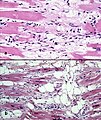Cardiomyopathy
Jump to navigation
Jump to search
The printable version is no longer supported and may have rendering errors. Please update your browser bookmarks and please use the default browser print function instead.
Cardiomyopathy, abbreviated as CM, is a domain of cardiology and forensic pathology, as many cardiomyopathies can lead to sudden death.
Overview
Types[1]
- Dilated cardiomyopathy - most common ~ 90%
- Hypertrophic cardiomyopathy
- Restrictive cardiomyopathy - least common
Note: The frequency of the CMs is in alphabetic order dilated, hypertrophic, restrictive.
Dilated cardiomyopathy
- Abbreviated DCM.
General
- Most common of the cardiomyopathies.
Causes:
- Myocarditis - leading cause, usually viral.[2]
- Familial ~ 30% - can be AD with variable penetrance, AR, X-linked.
- In the forensic context, usually caused by alcoholism.[3]
Microscopic
Features:
- Epicardial fibrosis.
- Usually non-specific.
DDx:
- Mitochondrial myopathy.
- Perinuclear clearing on light microscopy due to abundant mitochondria.
- Atypical mitochondria on electron microscopy.
- Muscular dystrophy.
- Storage disease.
IHC
Work-up for muscular dystrophy:
- Dystrophin.
Work-up for mitochondrial disease:
- COX.
- SDH.
Hypertrophic cardiomyopathy
- Abbreviated HCM.
General
- Genetic.
- Classic cause of sudden death in young athletes.[4]
Gross
- Classic: septum:left ventricular free wall = 1.5:1.0.[5]
Microscopic
Features:[6]
- Myocardial fibres have increased transverse size (~40 micrometres) - key feature.
- Normal myocardial fibre width = 15 micrometres.
- Haphazard arrangement of myocardial fibres;[7] "basket weave" pattern.
- Interstitial fibrosis.
- NOT diffuse patch/area as in an old myocardial infarction.
- Large hyperchromatic nuclei (~3x fibroblast nucleus).[8]
Notes:
- Easiest to identify if sections are perpendicular to the long axis of the myocytes.
Images:
Variants
Hypertrophic obstructive cardiomyopathy
- Abbreviated HOCM.
- Considered to be a variant of HCM.
- Historically known as idiopathic hypertrophic subaortic stenosis (IHSS).
Apical HCM
- AKA Japanese variant.[9]
- Mid-ventricular septal thickening or apical thickening (NOT subaortic hypertrophy).
Restrictive cardiomyopathy
- Uncommon form of cardiomyopathy.
Etiology
Multiple causes - an incomplete list:[10]
- Hemochromatosis - rare.[11]
- Hemochromatosis more commonly causes a DCM.
- Amyloidosis.
- Classically described as "stiff" or "rubbery".
- Sarcoidosis.
- Storage diseases (e.g. Pompe disease).
- Eosinophilic endocarditis (Loeffler Endocarditis).
Arrhythmogenic right ventricular cardiomyopathy
- Abbreviated ARVC.
- Previously known as arrhythmogenic right ventricular dysplasia, abbreviated ARVD.
General
- Associated with sudden cardiac death in "young people".[12]
- Male > female.
Etiology:
- Genetic - mutations in:
- Desmosomal proteins, especially plakoglobin and desmoplakin.
- Usually autosomal dominant.
- Autosomal recessive variant: Naxos syndrome.[13]
- Clinical: wooly hair, palmar & plantar keratoses.
Gross
Features:[14]
- Right ventricular wall thinning/replacement with fat. †
- Especially fat where fat is not usually seen - posterior RV wall, RVOT.
- Septum usually has relative sparing
- Thus, endomyocardial biopsy is not reliable.
- +/-Aneurysms/dilation.
Note:
- † May involve the left ventricle.[15]
Microscopic
Features:[14]
- "Moth-eaten" appearance:
- Loss of myocytes, replaced by:
- Fat and/or
- Scar tissue.
- Loss of myocytes, replaced by:
- +/-Inflammation (lymphocytes, macrophages).
- Myocytes have "bubbly" appearance with loss of myofibres and cross-striations.
Images
www
Noncompaction cardiomyopathy
Etiology
- Genetic - LVNC1 gene.[16]
- May be associated with dilation.[16]
- Rare.
- Not clear whether it is a unique entity.[17]
Gross
- Prominent "mesh-like" trabeculae carnae.
- Enlarged intertrabecular recesses.[18]
See also
- Heart.
- Cardiac sarcoidosis.
- Amyloidosis - covers cardiac amyloidosis.
References
- ↑ Cotran, Ramzi S.; Kumar, Vinay; Fausto, Nelson; Nelso Fausto; Robbins, Stanley L.; Abbas, Abul K. (2005). Robbins and Cotran pathologic basis of disease (7th ed.). St. Louis, Mo: Elsevier Saunders. pp. 601. ISBN 0-7216-0187-1.
- ↑ Luk A, Ahn E, Soor GS, Butany J (March 2009). "Dilated cardiomyopathy: a review". J. Clin. Pathol. 62 (3): 219–25. doi:10.1136/jcp.2008.060731. PMID 19017683.
- ↑ DiMaio, Vincent J.M.; Dana, Suzanna E. (2006). Handbook of Forensic Pathology (2nd ed.). CRC Press. pp. 43. ISBN 978-0849392870.
- ↑ Gojanovic B, Feihl F, Gremion G, Waeber B (February 2007). "[Sudden death in young athletes]" (in German). Praxis (Bern 1994) 96 (6): 189-98. PMID 17330410.
- ↑ JB. 9 June 2011.
- ↑ Cotran, Ramzi S.; Kumar, Vinay; Fausto, Nelson; Nelso Fausto; Robbins, Stanley L.; Abbas, Abul K. (2005). Robbins and Cotran pathologic basis of disease (7th ed.). St. Louis, Mo: Elsevier Saunders. pp. 601-3. ISBN 0-7216-0187-1.
- ↑ DiMaio, Vincent J.M.; Dana, Suzanna E. (2006). Handbook of Forensic Pathology (2nd ed.). CRC Press. pp. 44. ISBN 978-0849392870.
- ↑ CK. 14 October 2010.
- ↑ Reddy, M.; Thatai, D.; Bernal, J.; Pradhan, J.; Afonso, L. (Jul 2008). "Apical hypertrophic cardiomyopathy: potential utility of Strain imaging.". Eur J Echocardiogr 9 (4): 560-2. doi:10.1016/j.euje.2007.02.004. PMID 17392031.
- ↑ DiMaio, Vincent J.M.; Dana, Suzanna E. (2006). Handbook of Forensic Pathology (2nd ed.). CRC Press. pp. 44-5. ISBN 978-0849392870.
- ↑ Cutler, DJ.; Isner, JM.; Bracey, AW.; Hufnagel, CA.; Conrad, PW.; Roberts, WC.; Kerwin, DM.; Weintraub, AM. (Dec 1980). "Hemochromatosis heart disease: an unemphasized cause of potentially reversible restrictive cardiomyopathy.". Am J Med 69 (6): 923-8. PMID 7446557.
- ↑ Sudden cardiac death due to hypertrophic cardiomyopathy can be reduced by pre-participation cardiovascular screening in young athletes. URL: http://eurheartj.oxfordjournals.org/cgi/content/full/27/18/2152. Accessed on: 16 December 2009.
- ↑ http://www.ncbi.nlm.nih.gov/entrez/dispomim.cgi?id=601214
- ↑ 14.0 14.1 URL: http://emedicine.medscape.com/article/1612324-overview.
- ↑ Romero J, Mejia-Lopez E, Manrique C, Lucariello R (2013). "Arrhythmogenic Right Ventricular Cardiomyopathy (ARVC/D): A Systematic Literature Review". Clin Med Insights Cardiol 7: 97–114. doi:10.4137/CMC.S10940. PMC 3667685. PMID 23761986. https://www.ncbi.nlm.nih.gov/pmc/articles/PMC3667685/.
- ↑ 16.0 16.1 Online 'Mendelian Inheritance in Man' (OMIM) 604169
- ↑ Paterick TE, Gerber TC, Pradhan SR, Lindor NM, Tajik AJ (2010). "Left ventricular noncompaction cardiomyopathy: what do we know?". Rev Cardiovasc Med 11 (2): 92–9. PMID 20700091.
- ↑ Chin TK, Perloff JK, Williams RG, Jue K, Mohrmann R (August 1990). "Isolated noncompaction of left ventricular myocardium. A study of eight cases". Circulation 82 (2): 507–13. PMID 2372897.
